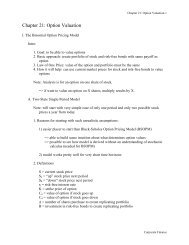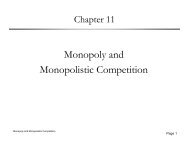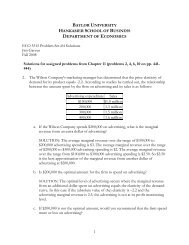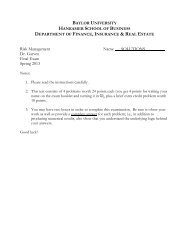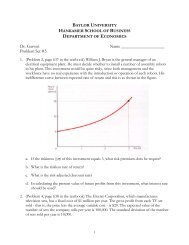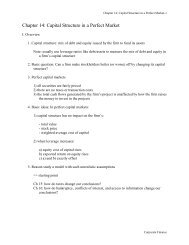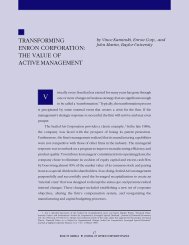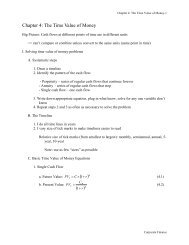Insurance Company Capital Structure Swaps and Shareholder Wealth
Insurance Company Capital Structure Swaps and Shareholder Wealth
Insurance Company Capital Structure Swaps and Shareholder Wealth
Create successful ePaper yourself
Turn your PDF publications into a flip-book with our unique Google optimized e-Paper software.
showing the value-maximizing action. In each case, we assume that the firms assets are invested in<br />
the market portfolio, with σ = 0.19, with no disagreement about their value 12 .<br />
6.1 Base Case<br />
First, we consider a case where managers <strong>and</strong> traders agree about the risk <strong>and</strong> value of both<br />
the asset <strong>and</strong> loss pools, <strong>and</strong> their correlation. To begin, we assume an asset pool (consisting of<br />
investments in the market portfolio, σ = 0.19) of $1,500, <strong>and</strong> a portfolio of insurance policies with<br />
an expected loss of $1,000 <strong>and</strong> σ = 0.4. In this case, the managers may issue $500 in equity <strong>and</strong> use<br />
the proceeds to purchase reinsurance, effectively reducing the firm’s expected loss portfolio $500,<br />
without changing the value of the assets. Alternatively, the firm may sell $200 in new policies<br />
<strong>and</strong> use the cash to retire equity, again without changing the value of assets. Assuming no taxes<br />
or market frictions for simplicity, we show in table 1 that shareholder wealth is not affected by<br />
leverage choices. These results are consistent with the predictions of Modigliani <strong>and</strong> Miller (1958)<br />
that in the absence of frictions, source of funding is irrelevant to shareholder value. 13<br />
6.2 Volatility Estimates Differ (Market Volatility Higher)<br />
In table 2, we consider two swaps when managers believe that reinsurance adds value for the firm<br />
due to differences in estimates of volatility. This is reasonable when managers know the contents<br />
of the underwriting files better than reinsurers, who rationally assume higher volatility, or when<br />
policyholders overestimate their risk. In the first case, the managers issue $500 of equity <strong>and</strong><br />
use the proceeds to purchase reinsurance in the same amount. In the second case, the managers<br />
12 Since the volatility of assets enters into the valuation equation in the V 2 term, it is important to use a reasonable<br />
estimate for the risk of the firm’s assets. If the firm holds treasury securities, the risk of the asset portfolio would<br />
go away <strong>and</strong> the model would simplify to a simple Black-Scholes put option held by the policyholders. If the firm<br />
holds a specialized portfolio of risky securities, the wealth change will be related to the relative risk of the assets <strong>and</strong><br />
losses as well as their correlation. However, since none of our swap examples include a change in asset holdings, nor<br />
a disagreement about the riskiness of the asset pool, the impact of our asset st<strong>and</strong>ard deviation parameter choice<br />
should be minimal. We use a long-run estimate of the st<strong>and</strong>ard deviation of annual returns on the market portfolio,<br />
calculated from the data available on Ken French’s website.<br />
13 Note that these results rely on the strong assumptions of Modigliani <strong>and</strong> Miller (1958) <strong>and</strong> Modigliani <strong>and</strong> Miller<br />
(1963), namely that there are no transaction costs <strong>and</strong> that individuals <strong>and</strong> corporations can borrow <strong>and</strong> lend at the<br />
same rate, <strong>and</strong> that investors <strong>and</strong> managers have access to the same information. In succeeding cases, the assumption<br />
of perfect information is relaxed, giving rise to arbitrage opportunities envisioned by Miller (1988), by which investors<br />
would eventually become aware of inside information.<br />
21



